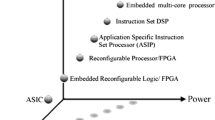Abstract
Motion vector (MV) prediction and residue coding technique is adopted to fully utilize the motion field redundancy in the prevailing video standards, and MV prediction is desired in both video encoder and decoder. The computation burden for MV prediction is not very high. However, there is high irregularity in raw MV prediction algorithm with two-stage and four-level hierarchical tree control flows. It makes efficient VLSI architecture implementation challenging. The high irregularity is mainly derived from the abundant inter prediction modes including variable block size partition and temporal prediction direction, as well as the irregular control flow of the MV prediction algorithm. This paper proposes a highly regular architecture to implement MV prediction for multi-standard video codec. Complex control logic is simplified by regularly table look-up of the control parameters predefined and stored in on-chip tables. The parameters of the current macroblock (MB) and its neighboring blocks are initialized and refreshed in a regular manner. Moreover, pipelining and parallelism are employed in the proposed architecture to improve throughput efficiency and tradeoff between hardware cost and efficiency. Simulation results verify the effectiveness of the proposed design.



















Similar content being viewed by others
References
Information Technology—Generic Coding of Moving Pictures and Associated Audio Information: Video, 1996.
Draft ITU-T Recommendation and Final Draft International Standard of Joint Video Specification, May 2003. Joint Video Team.
Wiegand, T., Sullivan, G. J., Bjontegaard, G., & Luthra, A. (2003). Overview of the H.264/AVC video coding standard. IEEE Transactions on Circuits and Systems for Video Technology, 13, 560–576.
SMPTE 421M, VC-1 Compressed Video Bitstream Format and Decoding Process, http://www.smpte.org/smpte_store/standards/pdf/s421m.pdf.
Information technology—Advanced coding of audio and video—Part 2: Video. AVS-P2 Standard Draft (2005).
Yoo, K., & Sohn, K. (2010). Hardware design of motion data decoding process for H.264/AVC. Signal Processing: Image Communication, 25, 208–223.
Zheng, J., Wu, D., Deng, L., Xie, D., Gao, W. (2006). A motion vector predictor architecture for AVS and MPEG-2 HDTV decoder, 7th Pacific-Rim Conference on Multimedia (PCM 2006), Hangzhou, China, pp. 424–431, Nov. 2–4.
Liu, T.-M., Lin, T.-A., Wang, S.-Z., Lee, W.-P., Yang, J.-Y., Hou, K.-C., et al. (2007). A 125 uW, fully scalable MPEG-2 and H.264/AVC video decoder for mobile applications. IEEE Journal of Solid-State Circuits, 42(1), 161–169.
Ding, L.-F., Chen, W.-Y., Tsung, P.-K., Chuang, T.-D., Hsiao, P.-H., Chen, Y.-H., et al. (2010). A 212MPixels/s 4096 × 2160p multiview video encoder chip for 3D/quad full HDTV applications. IEEE Journal of Solid-State Circuits, 45, 46–58.
Lin, C.-C., Chen, J.-W., Chang, H.-C., Yang, Y.-C., Ou Yang, Y.-H., Tsai, M.-C., et al. (2007). A 160K Gates/4.5 KB SRAM H.264 video decoder for HDTV applications. IEEE Journal of Solid-State Circuits, 42(1), 170–182.
Chien, C.-D., Chen, H.-C., Huang, L.-C., Guo, J.-I. (2005). A low-power motion compensation IP core design for MPEG-1/2/4 video decoding. In: IEEE International Symposium on Circuits and Systems, pp. 4542–4545.
Wang, S. Z., Lin, T. A., Liu, T. M., Lee C. Y. (2005). A new motion compensation design for H.264/AVC decoder. In Proc. IEEE ISCAS, pp. 4558–4561.
Zheng, J., Gao, W., Wu, D., Xie, D. (2008). A novel VLSI architecture of motion compensation for multiple standards. IEEE Transactions on Consumer Electronics, 54(2).
Suhring, K. (2005). JVT H.264/AVC reference software, JM 9.8, http://bs.hhi.de/suehring/tml.
AVS-Group. (2007). AVS1.0 part 2 reference software model, RM52j-r1, http://www.avs.org.cn.
Kim, Y., & Edmonson, W. (2006). H.264 video decoder design: Beyond RTL design implementation, IEEE Workshop on Signal Processing Systems Design and Implementation, SIPS, pp. 107–112.
Acknowledgments
This work was supported by ZJNSF Y1110114, NSFC 60802025 and 61001108, S&T project of Zhejiang province 2010C310075, the open project of State Key Laboratory of ASIC & System of Fudan University 10KF010, and the open project of SKL of Novel Soft Technology, Nanjing University (KFKT2012B09).
Author information
Authors and Affiliations
Corresponding author
Rights and permissions
About this article
Cite this article
Yin, H., Li, S., Qi, H. et al. A Regular VLSI Architecture of Motion Vector Prediction for Multiple-Standard MPEG-Like Video Codec. J Sign Process Syst 76, 47–62 (2014). https://doi.org/10.1007/s11265-013-0808-5
Received:
Revised:
Accepted:
Published:
Issue Date:
DOI: https://doi.org/10.1007/s11265-013-0808-5




